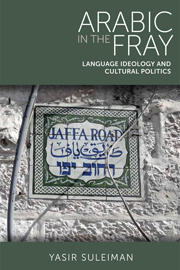Book contents
- Frontmatter
- Contents
- List of Figures
- Acknowledgements
- Dedication
- Introduction
- 1 Language Construction and Language Symbolism
- 2 (In)imitability, (Un)translatability and Inter-Group Strife
- 3 Framing Arabic: Paratexts, Poetry and Language Ideology
- 4 Hybridity, Language Ideology and Cultural Politics
- 5 Through the Looking Glass: Arabic, Thought and Reality
- Conclusion
- Bibliography
- Index
2 - (In)imitability, (Un)translatability and Inter-Group Strife
Published online by Cambridge University Press: 05 October 2013
- Frontmatter
- Contents
- List of Figures
- Acknowledgements
- Dedication
- Introduction
- 1 Language Construction and Language Symbolism
- 2 (In)imitability, (Un)translatability and Inter-Group Strife
- 3 Framing Arabic: Paratexts, Poetry and Language Ideology
- 4 Hybridity, Language Ideology and Cultural Politics
- 5 Through the Looking Glass: Arabic, Thought and Reality
- Conclusion
- Bibliography
- Index
Summary
This chapter explores the two themes of group identity and inter-group conflict in the pre-modern Arabic-speaking world, in so far as they relate to language as a primary factor in articulating them. To achieve this, the chapter investigates three major sites of discussion and debate in Arab and Islamic theological, cultural and political life: the (in)imitability of the Qur'an, its (un)translatability and the inter-ethnic strife called shu'ūbiyya. The chapter develops parallel lines of discussion in each of these three sites, before it draws them together into a unified framework. The figure of Jahiz – one of the most prolific writers in the first four centuries of Islam – constitutes the fulcrum of this unified framework. His theory of language as a semiology of semiologies is interpreted against the socio-political context of the day to reveal its historical situatedness. The chapter emphasises the continued relevance of the notions of construction, language symbolism and language as proxy, which we encountered in Chapter 1, in understanding aspects of the pre-modern world.
Introduction
The association of Arabic with group identity is inscribed in the lexical link between the name of the people, 'arab, and that of the language, 'arabiyya, in a way which may not be mirrored with similar transparency or connectedness in other language situations. The root meaning of both names is semantically related to the notions of: (1) speaking clearly, plainly, distinctly or perspicuously in a way that is free of incorrectness, corruption or barbarousness; (2) making a person recoil from foul speech or obscene language; and (3) knowing a horse by his neighing to be of pure Arab blood.
- Type
- Chapter
- Information
- Arabic in the FrayLanguage Ideology and Cultural Politics, pp. 51 - 92Publisher: Edinburgh University PressPrint publication year: 2013



